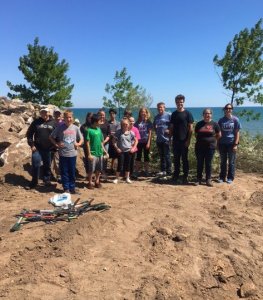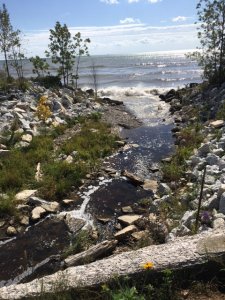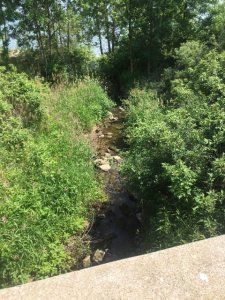Woodland Dunes Then & Now

The Spirit of the Rivers sculpture near the mouth of Forget-Me-Not Creek commemorates the native people who stewarded this ecosystem for millenia
Just across the West Twin River from the City of Two Rivers, neo-tropical songbirds, Monarch butterflies, bats, amphibians, mammals, and over 400 plant species flourish among the glacial ridges and swales of the 1,500-acre Woodland Dunes Nature Center and Preserve. Before colonization, indigenous people set up villages on these riverbanks and crested the sandy ridges. The preserve’s hardwood and conifer forests, wetlands, and prairies have evolved through modern day challenges. In the past decade, thanks to human efforts to reverse some of the damage wrought by pollution, habitat loss, and degradation, Woodland Dunes is experiencing a gentle resurgence of biological strength and diversity.
In 2015, the Fund for Lake Michigan awarded the preserve a grant to restore segments of its Forget-Me-Not-Creek, a two-mile stream that empties into Lake Michigan just south of Two Rivers.

A team of youth volunteers helped clear non-native shrubs
At the time, fish barriers near the mouth of the stream blocked passage to Lake Michigan, impeding spawning and other activity necessary to sustain salmon, smallmouth bass, northern pike, and other fish populations. Non-native shrubs surrounded the creek, choking out vital flora and diminishing water quality.
With FFLM’s financial support, the preserve dismantled the fish barriers and restored upstream wetlands to substantially improve habitat and water quality. Local YMCA youth and other volunteers helped remove the buckthorn and honeysuckle to make room for the native wetland, grassland, and shrub species that were planted. An excavator carved a series of carefully designed pools and riffles in the streambed.
Today, where Forget-Me-Not Creek meets Lake Michigan is an oasis of plant diversity and unfettered aquatic life. Surrounding marshes host migratory birds and other wetland-dependent species and keep harmful phosphorus and sediment from flowing down the creek into Lake Michigan. Monthly water quality monitoring evidences steady improvement.

After: In 2021, wildflowers bloom on the banks of a free-flowing creek

Before: The mouth of Forget-Me-Not Creek in 2015
Beyond achieving the project goals of substantially enhancing habitat and water quality, the Forget-Me-Not Creek restoration has seeded activity in and around Woodland Dunes. With grant funds from partner organizations, the preserve brought back an additional 100 wetland acres and is beginning to restore another segment of the creek. The City of Two Rivers, inspired by the newly-established native grasslands, is working with the preserve to expand pollinator habitat into City-owned property to the south. UW Sea Grant has instituted a fish survey, and Chicago’s Shedd Aquarium is measuring spring sucker spawning.
“All this stems from the initial funding received from the Fund for Lake Michigan five years ago,” said Woodland Dunes Nature Center and Preserve Executive Director Jim Knickelbine. “We are excited at the level of local support and engagement that has resulted from the project, and we look forward to continuing habitat restoration in and around the creek.”
Spring is an exciting time to visit Woodland Dunes. Pack your binoculars and meander along the preserve’s seven miles of hiking trails to feel the rhythms of its unique biological abundance. Look up. Nearly 300 different birds, including threatened species, have been sighted in here. For a water-based perspective, paddle the Twin Rivers Water Trail. Keep an eye out for otter, mink, badgers, coyotes, foxes, insects, and the aquatic life that abounds in these renewed waters of the Lake Michigan basin.